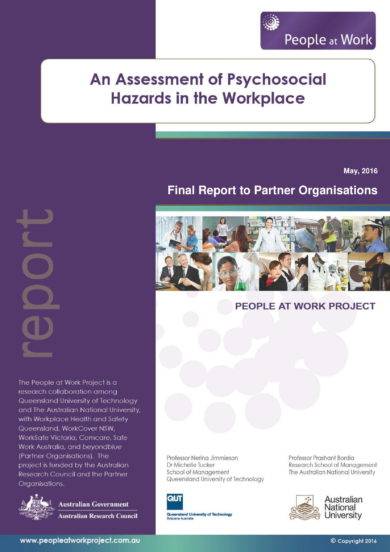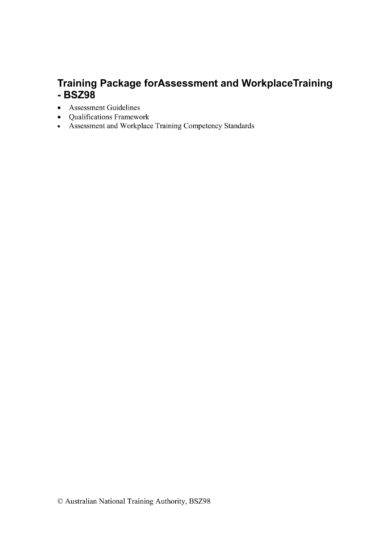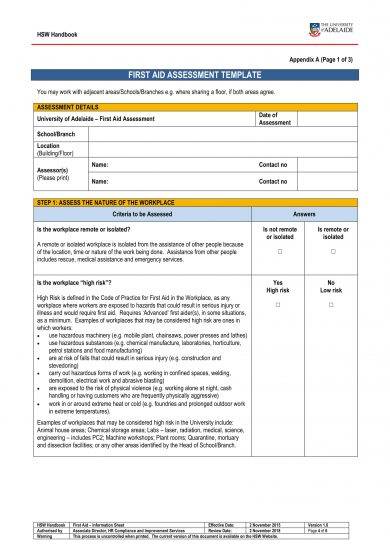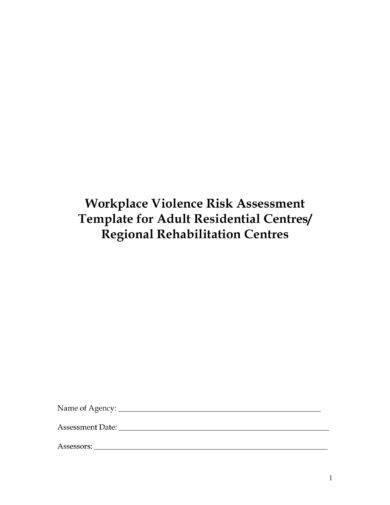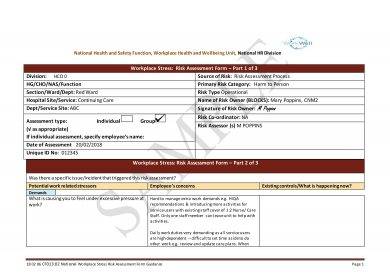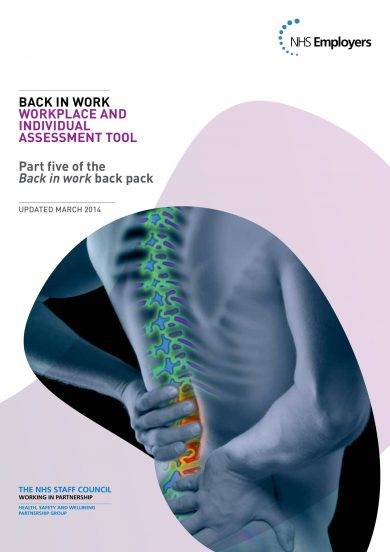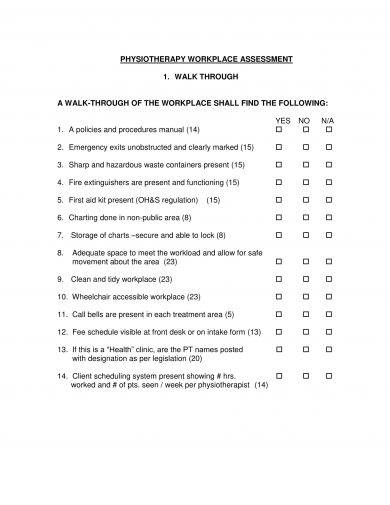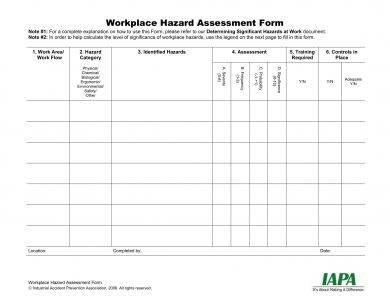9+ Workplace Assessment Examples to Download
Evaluating and reviewing all the areas and aspects of your business or organization can help you further develop a work culture that can give the business higher chances of being sustainable and marketable as it achieves its goals and vision.
Workplace assessments can target specific business elements and processes. There are particulars that are necessary to be considered when creating IT assessments, workforce assessments, and other kinds of assessments that are very precise when it comes to assessing the specific area of the business that must be included and reported in the final draft of the document.
Workplace assessments are not limited to be used for a single-area study, research, and evaluation. A workplace assessment can also be a general assessment of the company and its operations. What is important when using a workplace assessment is for entities to be aware of how to truly use the document so that proper items for assessment can be measured and/or evaluated accordingly.
Use the examples that you can download in this post if you want to know more ways on how you can layout the document and how you can efficiently collect all the details that you need for the assessment’s presentation.
Workplace Psychosocial Hazards Assessment Template Example
Workplace Assessment and Training Template Example
Workplace Hazard Assessment Template Example
Advantages of Using Workplace Assessments
A workplace assessment does not only benefit the management and the business owners. This document is also beneficial to the workforce or the employees of the business. If done correctly and accordingly, a workplace assessment can be a powerful tool that can promote the implementation of necessary changes to help better business operations, standards, and processes. Some of the advantages of using workplace assessments include the following:
1. Workplace assessments promote a safer, cleaner, and healthier work environment. It can also lead to the existence of a friendly and hazard-free workplace that can reduce absenteeism, lack of productivity, inefficiency, and health concerns. You may also see performance assessment examples.
2. Workplace assessments can give the business an easier time to fulfill particular legal requirements. There are some business requirements and auditing activities that are related to location safety and emergency preparedness, hygiene, and operational standards. You may also like career assessment examples.
With a workplace assessment at hand, businesses can execute reviews and evaluations at particular time periods which can give them more confidence with the way they implement quality requirements and specifications.
3. Workplace assessments help organizations to measure different areas, elements, and activities of the business. These allow them to be more critical when looking into factors that affect the performance of employees and the overall productivity of the business. You may also check out assessment plan examples & samples.
4. Workplace assessments ensure that the workforce is safe, secured, and protected from immediate danger or even potential harm. With the usage of a workplace assessment, risks and threats can be listed. This process can then lead to activities like work area maintenance, workflow improvement, and workplace development. You might be interested in assessment questionnaire examples.
5. Workplace assessments, like needs assessment examples, can help the workforce to present their concerns, questions, and inquiries. Workplace assessments can be used to gather information in an objective, civil, and professional manner. Hence, the firsthand information that the business will get are raw, credible, and realistic.
Workplace First Aid Assessment Template Example
Workplace Violence Risk Assessment Template Example
Office-Based Business Risk Assessment Template Example
Things to Consider When Creating Workplace Assessments
You have to be well-aware of the purpose and usage of your workplace assessment. Being knowledgeable on how you can maximize the potential and usage of this document can give you more favorable and beneficial results.
Listed below are some of the factors and elements that you have to look into whenever you have already decided to create a workplace assessment:
1. First, research about the regulations and law that you need to consider and review. This will help you identify the particular kind of workplace assessment that will best fit with your intentions and the specifications of the industry where your business belongs as well. Moreover, this can give you a more accurate decision-making directive when selecting the workplace assessment material to use. You may also see risk assessment examples.
2. Look into the previous workplace assessments of the business. Referencing from the past assessments of the workplace can give you more information about the conditions of the business before and how particular workplace assessments helped improve these conditions or the other way around. You may also like nursing assessment examples.
3. It is imperative for you to be particular with the business needs and demands that your workplace assessment will address. Doing this can make the document relevant and related not only to the operations of the business but also to the work processes, rights, and responsibilities of the stakeholders of the business. You may also check out health assessment examples.
As an example, if you will use a workplace assessment to measure the productivity of the workforce, then you have to make sure that you will include items of discussion about particular quality standards achievement, current business conditions, basic skills assessment, departmental effectiveness, individual performance, and work process efficiency.
4. Make sure that you will be as objective as possible when creating and using workplace assessment. You have to minimize or even remove activities of fraud and cheating as these will only lead to the negation of the reason why the workplace assessment is made.
Always remember that results of workplace assessment will not be all positive. However, you should not be ashamed of poor results as knowing information about these can help your business plan accordingly and change processes or activities that hinder your organization to achieve success. You might be interested in risk assessment questionnaire samples.
Workplace Stress Risk Assessment Form Template Example
Workplace and Individual Assessment Tool Template Example
Physiotherapy Workplace Assessment Template Example
Workplace Hazard Assessment Form Template Example
Tips and Guidelines When Creating a Workplace Assessment
A workplace assessment is a document that can give a lot of advantages and benefits to a business. If you truly want to make the most out of using this material, you have to ensure that you will be unbiased from the planning of the workplace assessment content up to the evaluation of its results. You may also see self-assessment examples & samples.
A few of the tips and guidelines that you can incorporate in the creation of your workplace assessment include the following:
1. Use assessment examples that deal with the evaluation of workplace processes, materials, relationships, and activities as your guides and references. It will be best for you if you will be guided by actual and existing documents so that you can have more idea on what to put or include in the document that you plan to make.
2. Use workplace inspection checklist examples so that you can list down all the details that you need to include in the workplace assessment. This can help you a lot in identifying the things that you have done, the items that you still need to execute, and the areas that you still need to look into and assess to gather the results that should be seen in the workplace assessment.
3. Do not overlook the financial aspect of the workplace assessment. You have to list down the expected cost that must be allotted in the activity especially in relation to data gathering and expert insight/evaluation. This will allow your business to have results that are of quality. You may also like evaluation questionnaire examples & samples.
4. If you are having a hard time in formatting the workplace assessment, refer to templates. Having a pre-formatted document can give you a more efficient time in creating the layout of the document. Moreover, it can help you make a more business-appropriate and presentable document. You may also check out evaluation plan examples & samples.
5. Know the issues that your workplace assessment would like to address. Doing this can help you be more specific with what to include in the document. More so, this will help your business to get information that are necessary and helpful to its intentions.
6. Seek for the comments and recommendations of the stakeholders of the business especially from those who are considered as decision-makers of the company.
Since workplace assessments are directly used for the planning of development programs, then you have to make sure that stakeholders are aware of what it will include and what the purpose of the document is. It is also suggested for you to let stakeholders be aware of the results of the workplace assessment as it can make them feel more involved. You might be interested in useful performance evaluation forms.
We hope that you will maximize the usage of the guidelines and examples that we have put together in this post. Always ensure to review the content and layout of the downloadable examples so that you can assess whether the example that you will select is highly usable when aligned to the particular requirements and specifications of the workplace assessment that you are tasked to develop. You may also see interview evaluation form examples.



